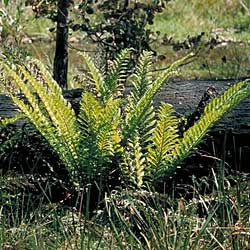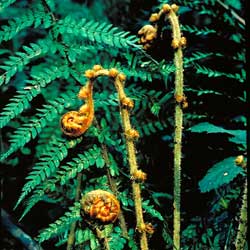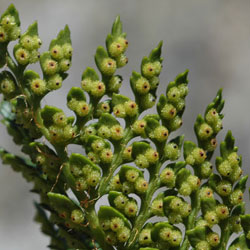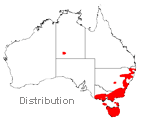Polystichum proliferum
 |
 |
 |
Mother Shield Fern
Polystichum proliferum (R.Br.) C.Presl (1836)
Polystichum proliferum is a hardy, cool climate terrestrial fern with attractive dark green divided fronds. Its ease of propagation and versatility makes it an ideal horticultural plant which grows well in a wide range of conditions.
 Polystichum proliferum is found on the tablelands and ranges of eastern NSW, Victoria and Tasmania. It occurs at high altitudes in alpine regions, where it often is found growing amongst boulders, and at lower altitudes in moist forest areas. It typically grows along creeks and in gullies, favouring the cooler and moister southern and eastern aspects.
Polystichum proliferum is found on the tablelands and ranges of eastern NSW, Victoria and Tasmania. It occurs at high altitudes in alpine regions, where it often is found growing amongst boulders, and at lower altitudes in moist forest areas. It typically grows along creeks and in gullies, favouring the cooler and moister southern and eastern aspects.
Polystichum proliferum is a terrestrial fern to 130cm high, with a thick rhizome which forms a stout trunk up to 10cm in diameter in older plants. The rhizome and frond bases are covered in persistent scales which are glossy brown with pale edges. The fronds, which can be 100cm in length, are dark green, leathery and 2-3 divided. The rachis tips have proliferous buds from which young plants, or bulbils, develop. The sori occur in a row on either side of the midrib and are covered by a prominent circular indusium with a dark central spot. It is from the proliferous tips and indusia that the common name, Mother Shield Fern is derived, as it ‘mothers’ offspring and the indusium ‘shields’ the sporangium during development.
Polystichum proliferum is frost hardy and favours cool, moist areas. It will grow on a wide range of soils, preferring well-drained soil with plenty of organic matter. Filtered shade is ideal, though Polystichum proliferum will tolerate full sun for short periods. It benefits from mulching with organic matter, but will suffer if leaf litter is allowed to build up in its crown. There are no serious pests of this fern. Polystichum proliferum is able to colonise new areas as bulbils on the frond tips reach the ground and grow new plants, making it an attractive feature in a garden.
Plants can be easily propagated from bulbils. Fronds with bulbils can be pinned to the ground in the garden and allowed to take root, or the bulbils can be removed from the fern by cutting the frond into segments. The base of these bulbils (still attached to a piece of frond) can then be dipped in rooting powder or gel, placed in moist sand in a punnet or tray and kept moist until roots have formed, when they can be potted on or planted out. Polystichum proliferum can also be propagated from spores.
Text by Meredith Cosgrove (2006 Student Botanical Intern)
Name meaning: Polystichum proliferumPolystichum - from Greek poly, many and stichos, rows, referring to rows of sori proliferum - from Latin proli, offspring, fer – bearing, referring to the proliferous buds. |
Link to Native Ferns for Cool Climates webpage: http://www.anbg.gov.au/ferns/ferns.html
References
Chaffey, Calder H. 1999, Australian Ferns: Growing them Successfully, Kangaroo Press, East Roseville, NSW
Costin, A.B et al. 2000, Kosciusko Alpine Flora, 2nd edition, Melbourne, CSIRO Publishing
McCarthy, P.M. (ed) 1998, Flora of AustraliaVolume48, Ferns, Gymnosperms and Allied Groups, Melbourne: ABRS/CSIRO Australia
Jones, D.L. and Clemesha, S.C. 1981, Australian Ferns and Fern Allies, 2nd edition. A.H. & A.W. Reed Pty Ltd, Sydney.
![An Australian Government Initiative [logo]](/images/austgovt_brown_90px.gif)

